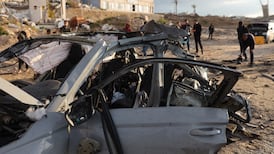Islamic militants have taken control of most of eastern Syria as they build on the momentum of their advance through Sunni Muslim provinces of neighbouring Iraq.
The Islamic State in Iraq and Syria (Isis), which claims authority over Muslims worldwide, has seized weapons from arms depots in both countries and money from bank vaults in cities it has overrun. It also controls oil fields and farmlands.
In Syria, the three-year-old uprising against President Bashar al-Assad is becoming a battle for supremacy among Sunni rebel groups, with Isis – which now refers to itself as the Islamic State – in the ascendant.
Its fighters drove al-Qaeda's Nusra Front from the Euphrates valley town of Albu Kamal on Syria's border with Iraq this week, securing their grip over both sides of a colonial era frontier which they say is now consigned to history.
That victory marked the first time the group has won full control over a crossing point and offers a platform for its offensive against Nusra Front positions in Syria's oil-producing province of Deir al-Zor.
Isis’s territory in Syria extends for 400km from the Turkish border near Al-Bab to the Iraq border at Albu Kamal – much of it seized in battles with rival militant forces rather than Assad’s troops.
While its latest gains in Syria are more incremental than the sweep through north and west Iraq in June, they highlight the continued expansion of a group that two years ago had no presence in the country.
“The developments over the past days have the most potential to change dynamics in Syria, after three years of tit-for-tat and stalemate,” said Patrick Skinner, a former intelligence officer with the CIA and an expert with the New York-based Soufan Group risk consultancy.
With a few thousand fighters of various nationalities in Syria, Isis is led locally by a militant from Georgia known as Abu Omar al-Shishani – “The Chechen”. Unlike its overall leader Abu Bakr al-Baghdadi, whose whereabouts are unknown, Shishani is frequently shown on the battlefield.
His fighters have proved ruthless in battle but also adept at using soft power – exploiting local alliances and grievances or buying off opposition.
The town of Mohassan, just 16km south of Deir al-Zor’s military airport, for example, was taken without a fight through an alliance with local chiefs which activists suspect involved some form of payment.
“Otherwise it makes no sense because Mohassan chiefs vehemently oppose Islamic State ideology,” said local activist Abu Hamza al-Deiri.
Videos of Isis brutality and overt displays of force, also play a role in projecting the movement’s authority.
On Monday it paraded military hardware through the streets of Raqqa, the only Syrian provincial capital to have fallen completely outside Assad’s control. It has besieged Assad’s forces in the city of Deir al-Zor for nearly three months, in a move that Deiri said echoed the government’s own tactics of “starvation until submission”.
Until recently Isis was largely left alone by Assad’s forces, who concentrated on regaining areas of central Syria and benefited from the internecine rebel fighting triggered by the Islamic State’s expansion. – (Reuters)












